
dumbod2: homonuclear dipole-dipole windowed-dumbo decoupling pulse program for TopSpin2.1
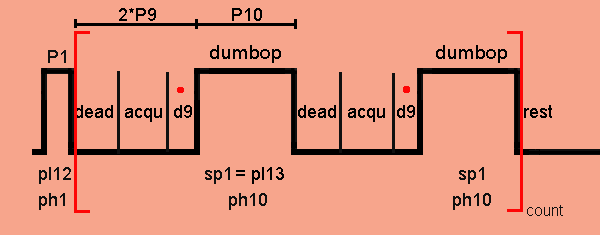
;dumbod2 (TOPSPIN 2.1) ;windowed DUMBO homonuclear decoupling, digital mode, ;Leskes, Madhu and Vega, Chem. Phys. Lett. modification to remove center spike ;HF 26.9.2007 ;spin 10-13 kHz according to RF field ;p9 2.4-4.5 usec, depending on probe deadtime, usually: ;for 200 and 300 MHz, CRAMPS probe required or use 4.5 usec, ;acqu or p9 must be as short as possible, avoiding dipolar coupling effects between DUMBO sequences, ;l11 or d9 must be as large as possible to improve S/N ratio, but keeping acqu positive, ;before ft, set s sw=sw/0.50 ;set: ;d1 : recycle delay ;p1 : proton 90 degree pulse at pl12 ;set o1p close to resonance ;pl12 : power level for initial pulse, ;pl13 : power level for DUMBO ;ns=n*4 ;spnam1=dumbo1, generated and set with au program dumbo; chose 1 cycle; uses p10 pulse ;at lower field, p10 is used as set (=32 usec), at higher field (500 MHz and up) 24 usec is better ;at higher power, of course. ;set l11=number of oversampled data points to be averaged into one dwell point, 2-32 depending on ;available window, more oversampled data points improve S/N, check acqu in ased to be finite ;$COMMENT=homonuclear decoupling with dumbo ;$CLASS=Solids ;$DIM=1D ;$TYPE=homonuclear decoupling ;$SUBTYPE=explicit acquisition ;cnst11 : to adjust t=0 for acquisition, if digmod = baseopt "acqt0=1u*cnst11" "sp1=pl13" dwellmode auto #include <Avancesolids.incl> #include <Delayssolids.incl> "d9=0.1u*(l11)" ;set the sampling window, defined in Avancesolids.incl define delay dead "dead=1.2u" define delay acqu ;small window defined by p9, 2.5-4.5 usec depending "acqu=2*p9-1.2u-d9-.1u" ;on probe deadtime ;acqu or p9 must be as short as possible, avoiding dipolar coupling effects ;l11 or d9 must be as large as possible but keeping acqu positive define delay cycle "cycle=4*p9+2*p10+.1u" define loopcounter count "count=aq/cycle" ;make sure td datapoints are sampled define delay rest ;make sure sampling proceeds throughout the sequence "rest=aq-(count*cycle)" define pulse dumbop "dumbop=p10" ;p10 provided by au program dumbo "blktr2 = 0.6u" ;this opens the transmitter gate 0.6 usec before the ;pulse, so the transmitter noise is not sampled 1 ze ;acquire into a cleared memory 2 d1 pl12:f1 ;recycle delay 10u reset1:f1 ;synchronise pulse and detection RF STARTADC ;prepare adc for sampling, set reference frequency, defined in Avancesolids.incl RESETPHASE ;reset reference phase 1u rpp10 ;reset phase list pointer p1:f1 ph1 ;first 90 at pl12 .1u DWL_CLK_ON 4 dead acqu d9 RG_ON .1u RG_OFF ;take l11 complex data points (dumbop:sp1 ph10^):f1 dead acqu d9 RG_ON .1u RG_OFF (dumbop:sp1 ph10^):f1 lo to 4 times count ;make sure td points are sampled rest 1u DWL_CLK_OFF rcyc=2 ;next scan 5 100m wr #0 ;save data 6 exit ;finished ph0= 0 ph1= 0 1 2 3 ph10=0 2 ph30=0 ph31=0 1 2 3
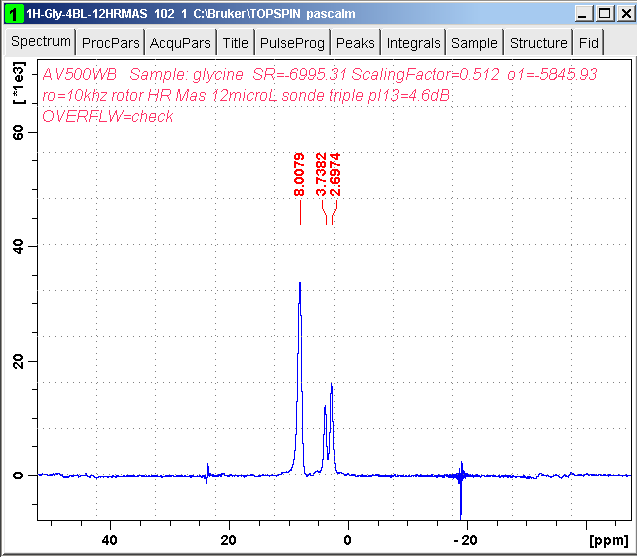
1H windowed DUMBO spectrum of glycine in a 4-mm diameter, 12-µL HRMAS rotor spinning at 10 kHz; P10 = 27 µs, H-XY probe; Glycine viewed with Jmol.
Pulseprogram parameters for dumbod2.ppm:
| General | |
| PULPROG | dumbod2.ppm |
| TD | 1000 |
| NS | 4 |
| DS | 0 |
| SWH [Hz] | 25000.00 |
| AQ [s] | 0.0200700 |
| RG | 16 |
| DW [µs] | 20.000 |
| DE [µs] | 4.50 |
| CNST11 | 0.0000000 |
| D1 [s] | 5.00000000 |
| d9 [s] | 0.00000360 |
| L11 | 36 |
| P9 [µs] | 2.80 |
| P10 [µs] | 27.00 |
| PL13 [dB] | 4.20 |
| acqu [s] | 0.00000070 |
| count | 307 |
| cycle [s] | 0.00006530 |
| dead [s] | 0.00000120 |
| rest [s] | 0.00002290 |
| Channel f1 | |
| dumbop [µs] | 27.00 |
| NUC1 | 1H |
| P1 [µs] | 4.40 |
| PL1 [dB] | 9.80 |
| PL12 [dB] | 9.80 |
| SFO1 [MHz] | 500.16415410 |
| SP1 [dB] | 4.2 |
| SPNAM1 | dumbo_1+0 |
| SPOAL1 | 0.500 |
| SPOFFS1 [Hz] | 0.00 |
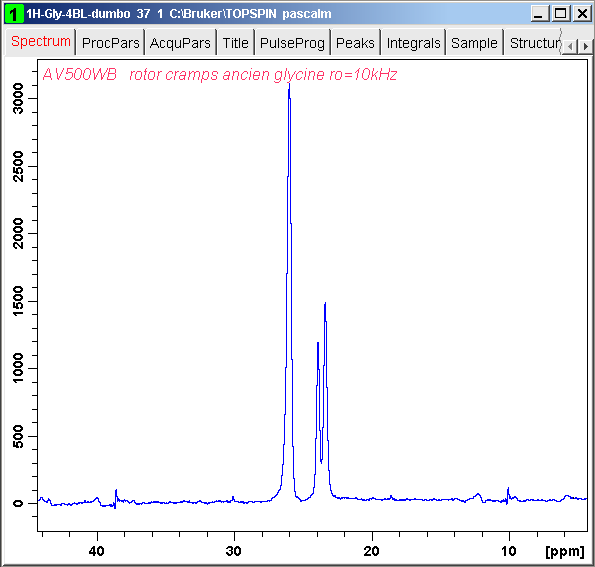
1H windowed DUMBO spectrum of glycine in a 4-mm diameter, 12-µL HRMAS rotor spinning at 10 kHz; P10 = 24 µs.
Pulseprogram parameters for dumbod2:
| General | |
| PULPROG | dumbod2 |
| TD | 700 |
| NS | 4 |
| DS | 0 |
| SWH [Hz] | 20000.00 |
| AQ [s] | 0.0175750 |
| RG | 4 |
| DW [µs] | 25.000 |
| DE [µs] | 4.50 |
| CNST11 | 0.0000000 |
| D1 [s] | 5.00000000 |
| d9 [s] | 0.00000260 |
| L11 | 26 |
| P9 [µs] | 2.60 |
| P10 [µs] | 24.00 |
| PL13 [dB] | 2.50 |
| acqu [s] | 0.00000130 |
| count | 300 |
| cycle [s] | 0.00005850 |
| dead [s] | 0.00000120 |
| rest [s] | 0.00002500 |
| Channel f1 | |
| dumbop [µs] | 24.00 |
| NUC1 | 1H |
| P1 [µs] | 2.00 |
| PL1 [dB] | 3.80 |
| PL12 [dB] | 3.80 |
| SFO1 [MHz] | 500.2121980 |
| SP1 [dB] | 2.50 |
| SPNAM1 | dumbo_1+0 |
| SPOAL1 | 0.500 |
| SPOFFS1 [Hz] | 0.00 |
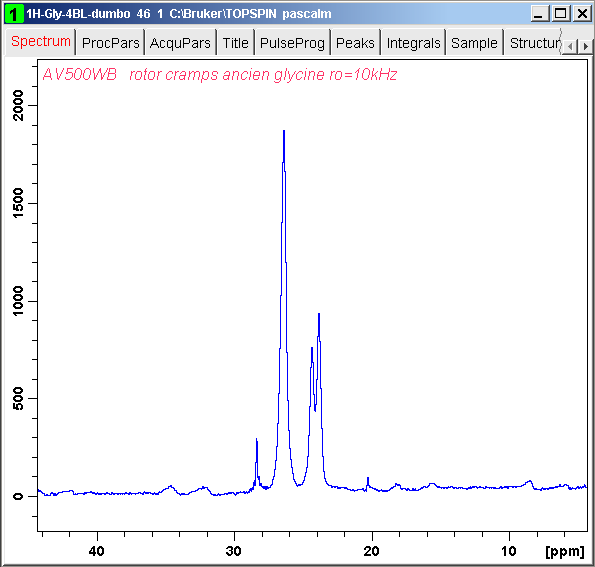
1H windowed DUMBO spectrum of glycine in a 4-mm diameter, 12-µL HRMAS rotor spinning at 10 kHz; P10 = 36 µs.
Pulseprogram parameters for dumbod2:
| General | |
| PULPROG | dumbod2 |
| TD | 700 |
| NS | 4 |
| DS | 0 |
| SWH [Hz] | 20000.00 |
| AQ [s] | 0.0175750 |
| RG | 4 |
| DW [µs] | 25.000 |
| DE [µs] | 4.50 |
| CNST11 | 0.0000000 |
| D1 [s] | 5.00000000 |
| d9 [s] | 0.00000300 |
| L11 | 30 |
| P9 [µs] | 2.80 |
| P10 [µs] | 36.00 |
| PL13 [dB] | 7.00 |
| acqu [s] | 0.00000130 |
| count | 210 |
| cycle [s] | 0.00008330 |
| dead [s] | 0.00000120 |
| rest [s] | 0.00008200 |
| Channel f1 | |
| dumbop [µs] | 24.00 |
| NUC1 | 1H |
| P1 [µs] | 2.00 |
| PL1 [dB] | 3.80 |
| PL12 [dB] | 3.80 |
| SFO1 [MHz] | 500.2121980 |
| SP1 [dB] | 7.00 |
| SPNAM1 | dumbo_1+0 |
| SPOAL1 | 0.500 |
| SPOFFS1 [Hz] | 0.00 |
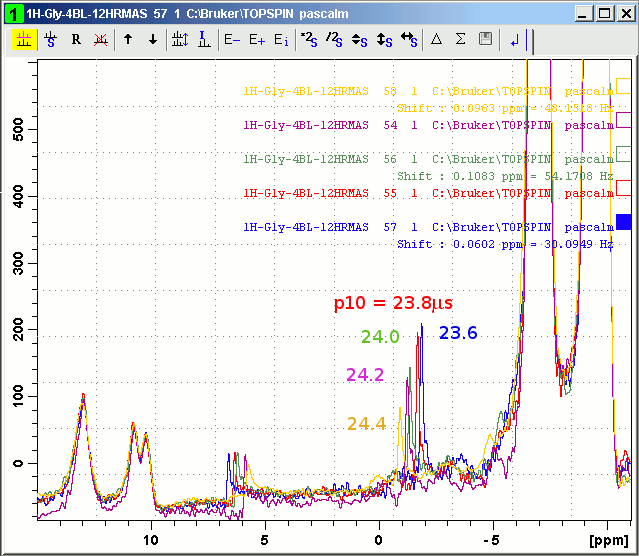
1H windowed DUMBO spectra of glycine in a 4-mm diameter, 12-µL HRMAS rotor spinning at 10 kHz; H-XY probe, for 5 DUMBO pulse duration p10 values (23.6, 23.8, 24.0, 24.2, and 24.4 µsec).
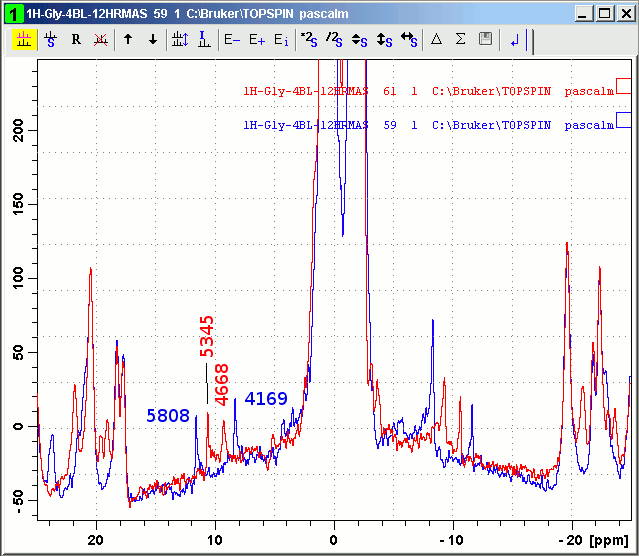
1H windowed DUMBO spectra of glycine in a 4-mm diameter, 12-µL HRMAS rotor spinning at ωrotor = 10 kHz and an H-XY probe, for 2 DUMBO pulse duration p10 values: 26 µsec (blue spectrum) and 27 µsec (red spectrum); rotor-RF peaks are located at 5808, 5345, 4668, and 4169 Hz relative to the carrier frequency.
The position f of a rotor-RF peak is defined by f = m*ωrotor + n/p10, where f, ωrotor, and p10 are expressed in Hz, kHz, and msec units, respectively.
The two rotor-RF peak positions 4169 and 4668 Hz allow us to determine the equation for the low frequency peak:
fL = 1764 ωrotor - 350/p10
The other two rotor-RF peak positions 5345 and 5808 Hz allow us to determine the equation for the high frequency peak:
fH = -642 ωrotor + 318/p10
Pulseprogram parameters for dumbod2.ppm:
| General | |
| PULPROG | dumbod2.ppm |
| TD | 700 |
| NS | 4 |
| DS | 0 |
| SWH [Hz] | 25000.00 |
| AQ [s] | 0.0140700 |
| RG | 4 |
| DW [µs] | 20.000 |
| DE [µs] | 4.50 |
| CNST11 | 0.0000000 |
| D1 [s] | 5.00000000 |
| d9 [s] | 0.00000360 |
| L11 | 36 |
| P9 [µs] | 2.80 |
| P10 [µs] | 26 and 27 |
| PL13 [dB] | 4.60 |
| acqu [s] | 0.00000070 |
| count | 240 |
| cycle [s] | 0.00005850 |
| dead [s] | 0.00000120 |
| rest [s] | 0.00003000 |
| Channel f1 | |
| dumbop [µs] | 24.00 |
| NUC1 | 1H |
| P1 [µs] | 4.00 |
| PL1 [dB] | 9.80 |
| PL12 [dB] | 9.80 |
| SFO1 [MHz] | 500.1661743 |
| SP1 [dB] | 4.60 |
| SPNAM1 | dumbo_1+0 |
| SPOAL1 | 0.500 |
| SPOFFS1 [Hz] | 0.00 |
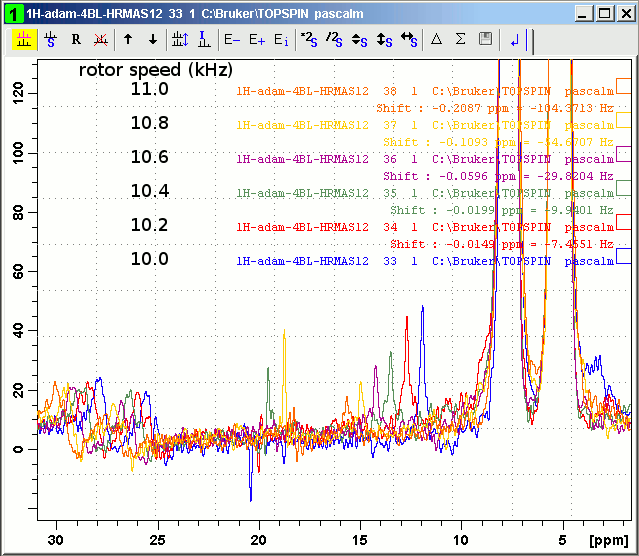
1H windowed DUMBO spectrum of glycine in a 4-mm diameter, 12-µL HRMAS with several rotor spinning speeds; P10 = 24 µs.
Pulseprogram parameters for dumbod2:
| General | |
| PULPROG | dumbod2 |
| TD | 700 |
| NS | 4 |
| DS | 0 |
| SWH [Hz] | 25000.00 |
| AQ [s] | 0.0140500 |
| RG | 1 |
| DW [µs] | 20.000 |
| DE [µs] | 4.50 |
| CNST11 | 0.0000000 |
| D1 [s] | 5.00000000 |
| d9 [s] | 0.00000260 |
| L11 | 26 |
| P9 [µs] | 2.60 |
| P10 [µs] | 24.00 |
| PL13 [dB] | 4.20 |
| acqu [s] | 0.00000130 |
| count | 240 |
| cycle [s] | 0.00005850 |
| dead [s] | 0.00000120 |
| rest [s] | 0.00003000 |
| Channel f1 | |
| dumbop [µs] | 24.00 |
| NUC1 | 1H |
| P1 [µs] | 2.00 |
| PL1 [dB] | 3.80 |
| PL12 [dB] | 3.80 |
| SFO1 [MHz] | 500.1650049 |
| SP1 [dB] | 4.20 |
| SPNAM1 | dumbo_1+0 |
| SPOAL1 | 0.500 |
| SPOFFS1 [Hz] | 0.00 |
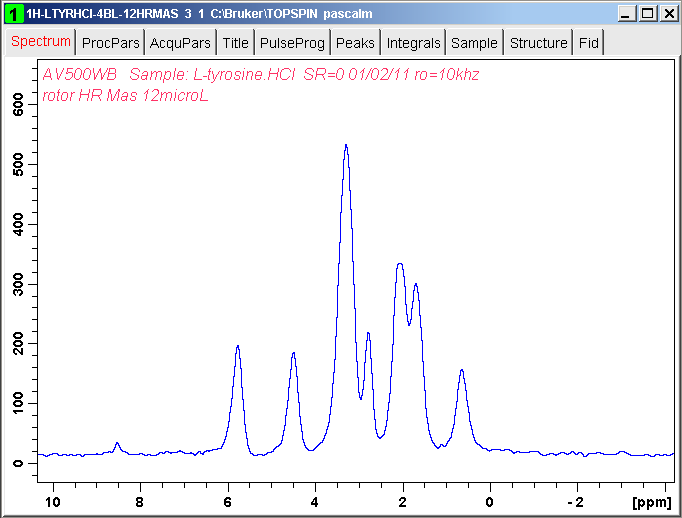
1H windowed DUMBO spectrum of L-tyrosine-HCl in a 4-mm diameter, 12-µL HRMAS rotor spinning at 10 kHz; P10 = 24 µs; L-tyrosine viewed with Jmol.
Pulseprogram parameters for dumbod2:
| General | |
| PULPROG | dumbod2 |
| TD | 700 |
| NS | 4 |
| DS | 0 |
| SWH [Hz] | 20000.00 |
| AQ [s] | 0.0175750 |
| RG | 4 |
| DW [µs] | 25.000 |
| DE [µs] | 4.50 |
| CNST11 | 0.0000000 |
| D1 [s] | 5.00000000 |
| d9 [s] | 0.00000200 |
| L11 | 20 |
| P9 [µs] | 3.00 |
| P10 [µs] | 24.00 |
| PL13 [dB] | 3.00 |
| acqu [s] | 0.00000270 |
| count | 292 |
| cycle [s] | 0.00006010 |
| dead [s] | 0.00000120 |
| rest [s] | 0.00002580 |
| Channel f1 | |
| dumbop [µs] | 24.00 |
| NUC1 | 1H |
| P1 [µs] | 2.50 |
| PL1 [dB] | 3.50 |
| PL12 [dB] | 3.80 |
| SFO1 [MHz] | 500.1709253 |
| SP1 [dB] | 3.00 |
| SPNAM1 | dumbo_1+0 |
| SPOAL1 | 0.500 |
| SPOFFS1 [Hz] | 0.00 |
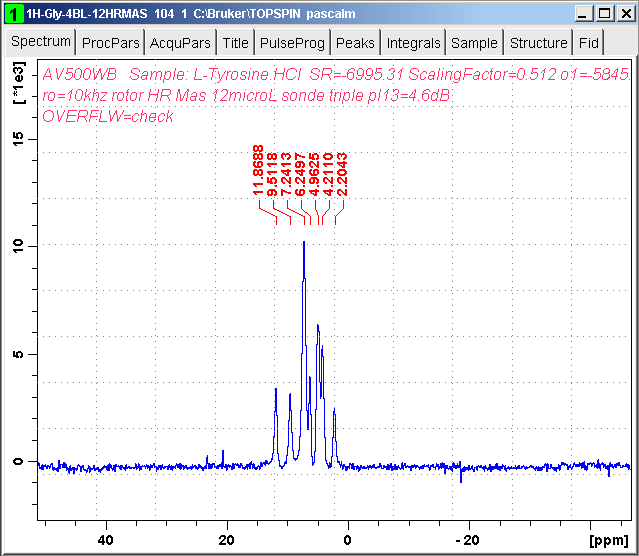
1H windowed DUMBO spectrum of L-tyrosine-HCl in a 4-mm diameter, 12-µL HRMAS rotor spinning at 10 kHz; P10 = 27 µs, H-XY probe.
Pulseprogram parameters for dumbod2.ppm:
| General | |
| PULPROG | dumbod2.ppm |
| TD | 1000 |
| NS | 4 |
| DS | 0 |
| SWH [Hz] | 25000.00 |
| AQ [s] | 0.0200700 |
| RG | 16 |
| DW [µs] | 20.000 |
| DE [µs] | 4.50 |
| CNST11 | 0.0000000 |
| D1 [s] | 5.00000000 |
| d9 [s] | 0.00000360 |
| L11 | 36 |
| P9 [µs] | 2.80 |
| P10 [µs] | 27.00 |
| PL13 [dB] | 4.20 |
| acqu [s] | 0.00000070 |
| count | 307 |
| cycle [s] | 0.00006530 |
| dead [s] | 0.00000120 |
| rest [s] | 0.00002290 |
| Channel f1 | |
| dumbop [µs] | 27.00 |
| NUC1 | 1H |
| P1 [µs] | 4.40 |
| PL1 [dB] | 9.80 |
| PL12 [dB] | 9.80 |
| SFO1 [MHz] | 500.1641541 |
| SP1 [dB] | 4.20 |
| SPNAM1 | dumbo_1+0 |
| SPOAL1 | 0.500 |
| SPOFFS1 [Hz] | 0.00 |
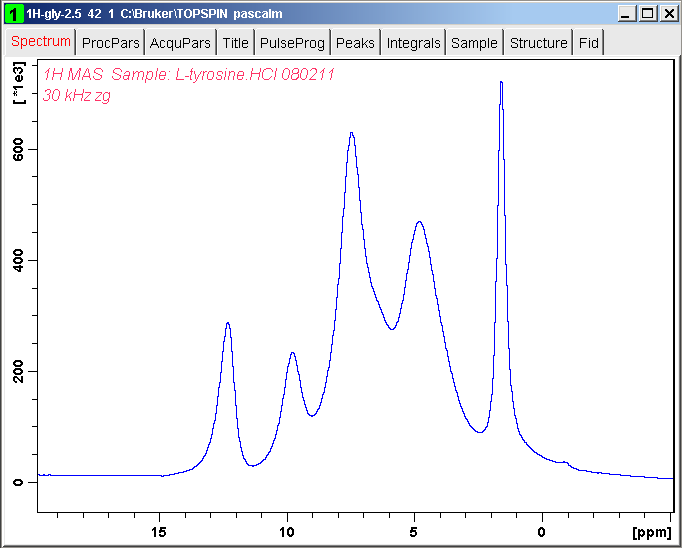
1H one-pulse spectrum of L-tyrosine-HCl in a 2.5-mm diameter rotor spinning at 30 kHz; P1 = 2.3 µs; PL1 = 2.25 dB; AV700SB.
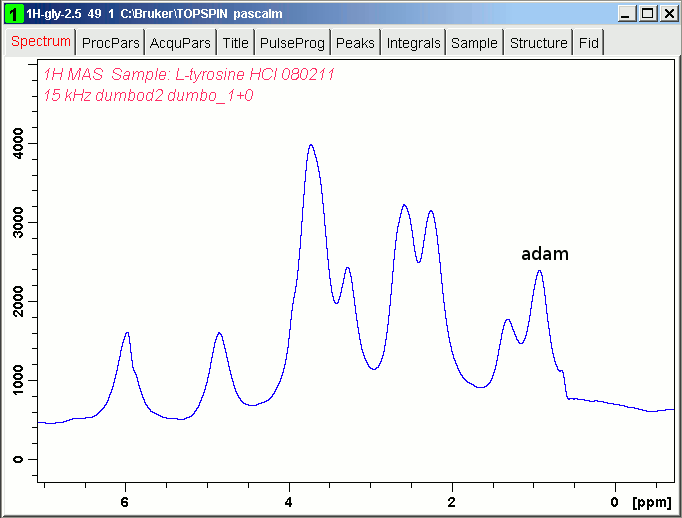
1H windowed DUMBO spectrum of L-tyrosine-HCl in a 2.5-mm diameter rotor spinning at 15 kHz; P10 = 36 µs, AV700SB.
Pulseprogram parameters for dumbod2:
| General | |
| PULPROG | dumbod2 |
| TD | 700 |
| NS | 4 |
| DS | 0 |
| SWH [Hz] | 14124.29 |
| AQ [s] | 0.0248654 |
| RG | 16 |
| DW [µs] | 35.400 |
| DE [µs] | 4.50 |
| CNST11 | 0.0000000 |
| D1 [s] | 5.00000000 |
| d9 [s] | 0.00000280 |
| L11 | 28 |
| P9 [µs] | 3.00 |
| P10 [µs] | 36.00 |
| PL13 [dB] | 5.00 |
| acqu [s] | 0.00000190 |
| count | 295 |
| cycle [s] | 0.00008410 |
| dead [s] | 0.00000120 |
| rest [s] | 0.00005590 |
| Channel f1 | |
| dumbop [µs] | 36.00 |
| NUC1 | 1H |
| P1 [µs] | 2.30 |
| PL1 [dB] | 2.00 |
| PL12 [dB] | 2.00 |
| SFO1 [MHz] | 700.1345530 |
| SP1 [dB] | 5.00 |
| SPNAM1 | dumbo_1+0 |
| SPOAL1 | 0.500 |
| SPOFFS1 [Hz] | 0.00 |
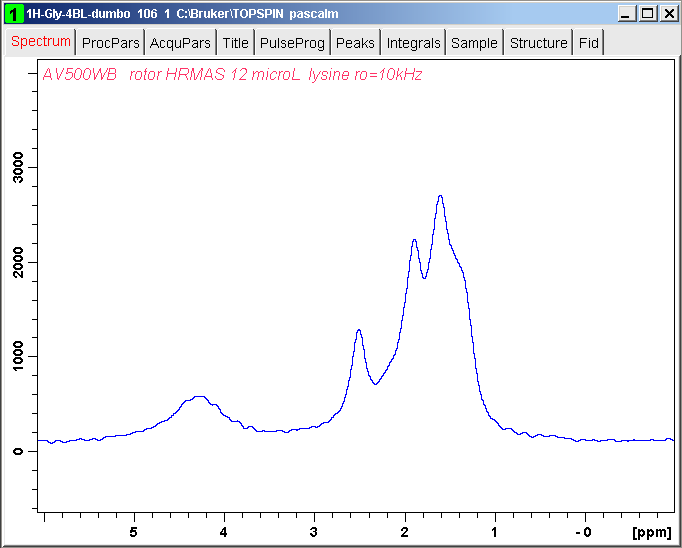
1H windowed DUMBO spectrum of L-lysine in a 4-mm diameter, 12-µL HRMAS rotor spinning at 10 kHz; P10 = 24 µs; L-lysine viewed with Jmol.
Pulseprogram parameters for dumbod2:
| General | |
| PULPROG | dumbod2 |
| TD | 700 |
| NS | 16 |
| DS | 0 |
| SWH [Hz] | 20000.00 |
| AQ [s] | 0.0175750 |
| RG | 4 |
| DW [µs] | 25.000 |
| DE [µs] | 4.50 |
| CNST11 | 0.0000000 |
| D1 [s] | 5.00000000 |
| d9 [s] | 0.00000260 |
| L11 | 26 |
| P9 [µs] | 2.60 |
| P10 [µs] | 24.00 |
| PL13 [dB] | 3.50 |
| acqu [s] | 0.00000130 |
| count | 300 |
| cycle [s] | 0.00005850 |
| dead [s] | 0.00000120 |
| rest [s] | 0.00002500 |
| Channel f1 | |
| dumbop [µs] | 24.00 |
| NUC1 | 1H |
| P1 [µs] | 2.00 |
| PL1 [dB] | 3.80 |
| PL12 [dB] | 3.80 |
| SFO1 [MHz] | 500.1653244 |
| SP1 [dB] | 3.50 |
| SPNAM1 | dumbo_1+0 |
| SPOAL1 | 0.500 |
| SPOFFS1 [Hz] | 0.00 |
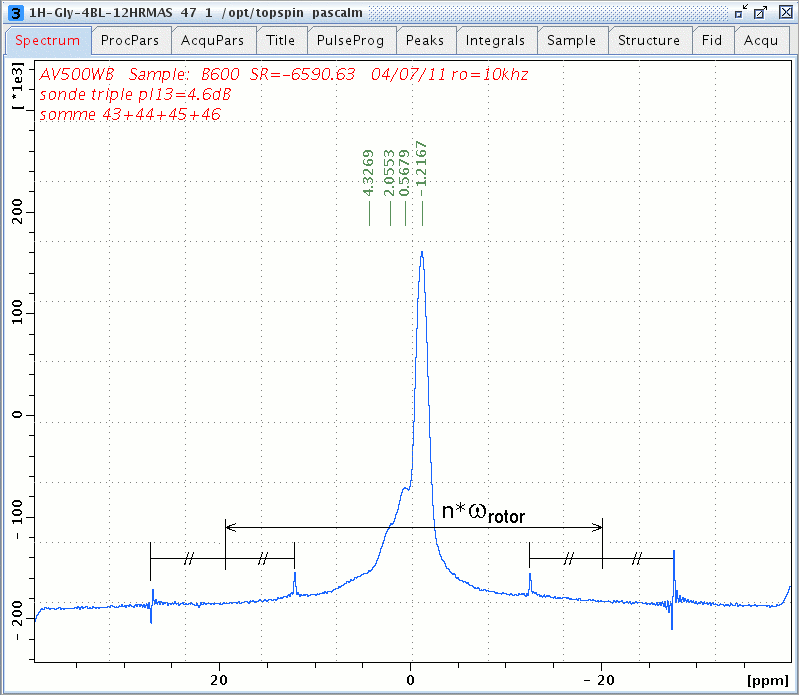
1H windowed DUMBO spectrum of MgO in a 4-mm diameter rotor spinning at ωrotor = 10 kHz; P10 = 24 µs; H-XY probe; n = 1 before the scaling of the F2 axis and n = 2 after the scaling of the F2 axis.
Pulseprogram parameters for dumbod2.ppm:
| General | |
| PULPROG | dumbod2.ppm |
| TD | 700 |
| NS | 10424 |
| DS | 0 |
| SWH [Hz] | 20000.00 |
| AQ [s] | 0.0175750 |
| RG | 4 |
| DW [µs] | 25.000 |
| DE [µs] | 4.50 |
| CNST11 | 0.0000000 |
| D1 [s] | 5.00000000 |
| d9 [s] | 0.00000360 |
| L11 | 26 |
| P9 [µs] | 2.80 |
| P10 [µs] | 24.00 |
| PL13 [dB] | 4.60 |
| acqu [s] | 0.00000070 |
| count | 296 |
| cycle [s] | 0.00005930 |
| dead [s] | 0.00000120 |
| rest [s] | 0.00002220 |
| Channel f1 | |
| dumbop [µs] | 24.00 |
| NUC1 | 1H |
| P1 [µs] | 4.00 |
| PL1 [dB] | 9.80 |
| PL12 [dB] | 9.80 |
| SFO1 [MHz] | 500.1632788 |
| SP1 [dB] | 4.60 |
| SPNAM1 | dumbo_1+0 |
| SPOAL1 | 0.500 |
| SPOFFS1 [Hz] | 0.00 |
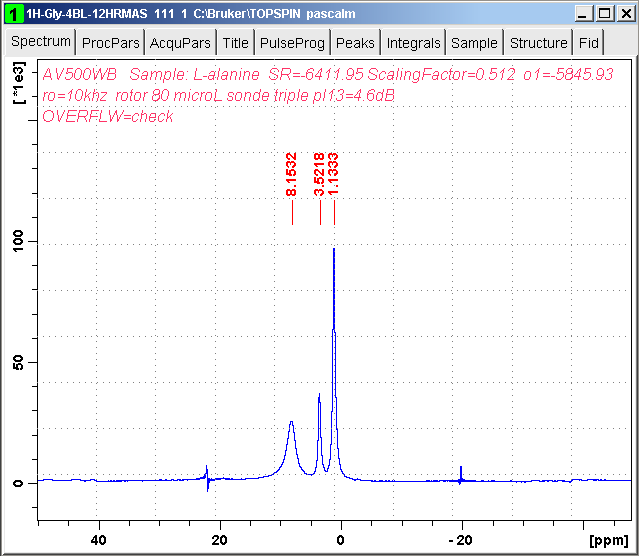
1H windowed DUMBO spectrum of L-alanine in a 4-mm diameter, 80-µL rotor spinning at 10 kHz; P10 = 27 µs, H-XY probe; L-alanine viewed with Jmol.
Pulseprogram parameters for dumbod2.ppm:
| General | |
| PULPROG | dumbod2.ppm |
| TD | 1000 |
| NS | 4 |
| DS | 0 |
| SWH [Hz] | 25000.00 |
| AQ [s] | 0.0200700 |
| RG | 16 |
| DW [µs] | 20.000 |
| DE [µs] | 4.50 |
| CNST11 | 0.0000000 |
| D1 [s] | 5.00000000 |
| d9 [s] | 0.00000360 |
| L11 | 36 |
| P9 [µs] | 2.80 |
| P10 [µs] | 27.00 |
| PL13 [dB] | 4.20 |
| acqu [s] | 0.00000070 |
| count | 307 |
| cycle [s] | 0.00006530 |
| dead [s] | 0.00000120 |
| rest [s] | 0.00002290 |
| Channel f1 | |
| dumbop [µs] | 27.00 |
| NUC1 | 1H |
| P1 [µs] | 4.40 |
| PL1 [dB] | 9.80 |
| PL12 [dB] | 9.80 |
| SFO1 [MHz] | 500.16415410 |
| SP1 [dB] | 4.2 |
| SPNAM1 | dumbo_1+0 |
| SPOAL1 | 0.500 |
| SPOFFS1 [Hz] | 0.00 |
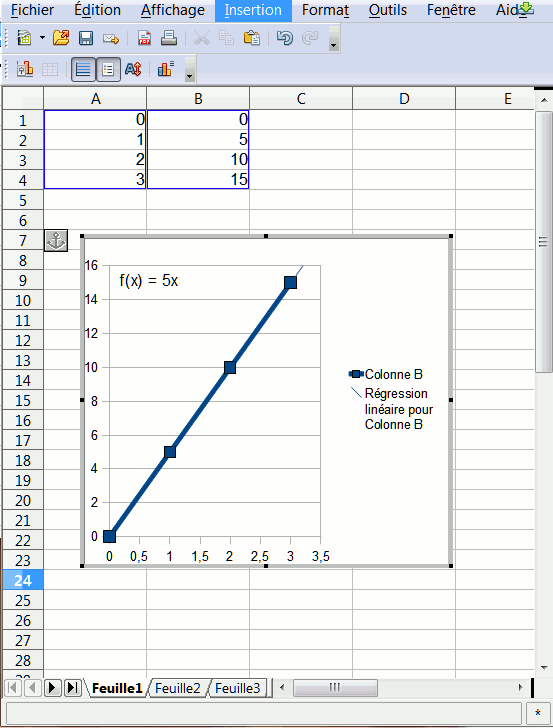
Correlation in OpenOffice.org Calc.